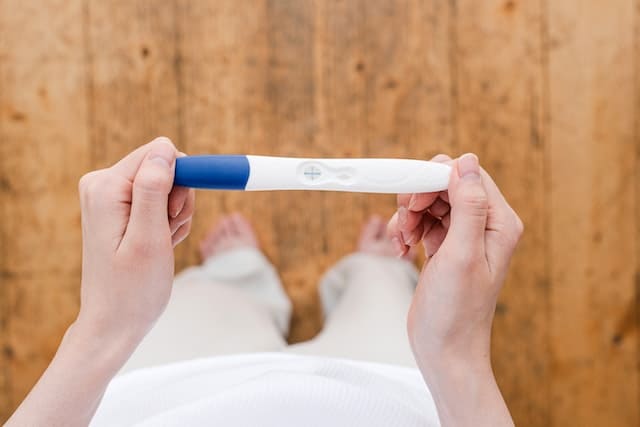The pencil test for pregnancy is a traditional method of determining if a woman is pregnant by using a pencil. This test has been used for generations and is still popular in some parts of the world. The pencil test is a simple and non-invasive way to determine if a woman is pregnant, but it is not always accurate.
To perform the pencil test, a woman places a sharpened pencil on the ground and straddles it. If the pencil moves, it is believed that she is pregnant. If the pencil remains still, she is not pregnant. This test is based on the idea that a pregnant woman’s body has a different energy field that can move the pencil.
While the pencil test is simple and easy to perform, it is not a reliable method of determining pregnancy. The test can be influenced by factors such as the surface the pencil is placed on, the woman’s balance, and even the pencil itself. Additionally, there is no scientific evidence to support the accuracy of the pencil test.
Key Takeaways
- The pencil test for pregnancy is a traditional method of determining pregnancy using a pencil.
- The test involves placing a sharpened pencil on the ground and straddling it to see if it moves.
- While the pencil test is simple and easy to perform, it is not a reliable method of determining pregnancy and there is no scientific evidence to support its accuracy.
The Pencil Test for Pregnancy: An Overview

The pencil test for pregnancy is a popular method used by many women to determine if they are pregnant. This test is often used as an alternative to traditional pregnancy tests, which can be expensive and sometimes unreliable. The test is simple and can be done at home with just a pencil.
To perform the pencil test, a pregnant woman holds a pencil over her wrist. If the pencil moves in a circular motion, it is believed that she is pregnant. If the pencil moves in a straight line, it is believed that she is not pregnant.
While the pencil test is often used as a fun way to determine pregnancy, it is important to note that it is not a scientifically proven method. There is no evidence to support the accuracy of this test, and it should not be relied upon as a sole means of determining pregnancy.
It is important for women who suspect they may be pregnant to seek medical advice from a healthcare professional. A healthcare professional can perform a pregnancy test and provide accurate information about pregnancy and prenatal care.
In conclusion, the pencil test for pregnancy is a popular method used by many women to determine if they are pregnant. While the test is simple and can be done at home, it is not a scientifically proven method and should not be relied upon as a sole means of determining pregnancy. Women who suspect they may be pregnant should seek medical advice from a healthcare professional.
The Process of The Pencil Test
The pencil test is a simple and easy way to determine pregnancy. The test involves using a pencil and a thread to create a pendulum that is used to predict the gender of the baby. Here is a step-by-step guide on how to perform the pencil test:
- Gather your materials: You will need a pencil and a piece of thread. Make sure the thread is long enough to hold the pencil without touching the ground.
- Tie the thread to the pencil: Tie one end of the thread to the eraser end of the pencil. Make sure it is tied securely so that the pencil does not fall off.
- Hold the thread with your wrist: Hold the other end of the thread with your wrist. Make sure your arm is extended and the pencil is hanging freely.
- Create a circle motion: Begin to move the pencil in a circular motion. It is important to keep the motion consistent throughout the test.
- Observe the movement: Watch the movement of the pencil. If it swings back and forth in a straight line, it is believed that the baby will be a boy. If it swings in a circular motion, it is believed that the baby will be a girl.
It is important to note that the pencil test is not a scientifically proven method for determining pregnancy or gender. It is simply a fun and interesting way to predict the gender of your baby.
Accuracy and Reliability
The pencil test for pregnancy is a popular method used in some cultures to determine the sex of an unborn baby. However, its accuracy and reliability have been questioned by medical professionals and scientists.
There is no scientific evidence to support the accuracy of the pencil test for pregnancy. The test involves suspending a pencil over the belly of a pregnant woman. If the pencil moves in a circular motion, it is believed to indicate that the baby is a girl. If the pencil moves back and forth, it is believed to indicate that the baby is a boy.
Medical professionals caution against relying on the pencil test for pregnancy as a reliable way of determining the sex of an unborn baby. The accuracy rate of the pencil test for pregnancy has not been established, and there is no guarantee that the results will be correct.
In addition, the pencil test for pregnancy does not provide any information about the health of the baby or the mother. It is important for pregnant women to seek medical care from a qualified healthcare provider to ensure the health and well-being of both the mother and the baby.
In summary, the pencil test for pregnancy is not a reliable or accurate way of determining the sex of an unborn baby. Pregnant women should seek medical care from a qualified healthcare provider for accurate and reliable information about their pregnancy.
Scientific Perspective and Healthcare Providers’ View

From a scientific perspective, the pencil test for pregnancy is not a reliable or accurate method to determine pregnancy. Healthcare providers generally do not recommend the use of this test and instead rely on more accurate methods such as blood tests, ultrasounds, and urine tests.
Blood tests are considered the most reliable way to confirm pregnancy. They measure the levels of human chorionic gonadotropin (hCG), a hormone produced by the placenta after a fertilized egg implants in the uterus. A missed period and a positive blood test are usually the first signs of pregnancy.
Ultrasounds can also confirm pregnancy and provide additional information such as the gestational age of the fetus and whether it is developing normally. Healthcare providers may use ultrasounds to diagnose ectopic pregnancies, which occur when the fertilized egg implants outside of the uterus.
Urine tests, including home pregnancy tests, are also commonly used to confirm pregnancy. These tests detect hCG in the urine and are generally accurate when used correctly.
Healthcare providers strongly advise against using the pencil test for pregnancy as it has not been scientifically proven to be accurate. This test involves suspending a pencil over the belly of a woman who suspects she may be pregnant. If the pencil moves, it is believed to indicate pregnancy. However, there is no scientific basis for this belief and the test is not reliable.
In summary, healthcare providers recommend using reliable and accurate methods such as blood tests, ultrasounds, and urine tests to confirm pregnancy. The pencil test for pregnancy is not recommended and should not be relied upon for accurate results.
Gender Prediction Using Pencil Test

The pencil test is a popular gender prediction method that has been used for generations. It is a simple and inexpensive way to predict the gender of an unborn baby. The test involves suspending a pencil over the pregnant woman’s belly. The movement of the pencil is then observed to determine the gender of the baby.
To perform the test, the pregnant woman lies down on her back and relaxes. A pencil is then held over her belly by someone else. The person holding the pencil must ensure that it is not touching the woman’s skin. The pencil is then observed for movement.
According to popular belief, if the pencil moves in a circular motion, the baby is a girl. If the pencil moves back and forth, the baby is a boy. However, it is important to note that there is no scientific evidence to support this claim.
It is also important to note that the pencil test is not always accurate. The movement of the pencil can be influenced by factors such as the woman’s breathing or muscle contractions. Therefore, it is best to use the pencil test as a fun way to predict the gender of the baby, rather than relying on it as a reliable method.
In addition to the pencil test, there are other gender prediction methods such as the baby gender ring test. However, it is important to remember that these methods are not scientifically proven and should not be relied upon for accurate gender prediction.
Overall, the pencil test is a fun and harmless way to predict the gender of an unborn baby. However, it should not be relied upon as a reliable method. It is always best to confirm the gender of the baby through medical means such as an ultrasound.
Safety and Potential Risks
When it comes to the pencil test for pregnancy, there are some safety concerns and potential risks that should be considered. While the test itself is a harmless experiment, there are some factors that could potentially lead to complications.
One of the main concerns is the risk of miscarriage. If a woman is pregnant and the pencil test is performed incorrectly or too aggressively, it could potentially cause harm to the developing fetus and lead to a miscarriage. It is important to approach the test with caution and to not apply too much pressure.
Another potential risk is the risk of misinterpreting the results. The pencil test is not a scientifically proven method of determining pregnancy and there is a risk of misreading the results. It is important to understand that the test is not foolproof and should not be relied upon as the sole method of determining pregnancy.
In terms of safety, it is generally considered safe to perform the pencil test as long as it is done correctly and with caution. However, it is important to note that the test should not be used as a substitute for medical advice or professional pregnancy testing.
Overall, while the pencil test for pregnancy is a popular and harmless experiment, it is important to approach it with caution and to understand the potential risks and limitations. Pregnant women should always consult with a healthcare professional for accurate and reliable pregnancy testing.
Variations and Fun Aspects
Although the pencil test for pregnancy is a simple and straightforward method, there are a few variations and fun aspects that can make the experience more enjoyable.
One variation is to use different types of pencils, such as colored pencils or mechanical pencils. This can add some excitement to the process and make it more visually appealing.
Another fun aspect is to involve family members or partners in the test. This can be a bonding experience and create a sense of togetherness during the pregnancy journey.
For those who enjoy DIY projects, making a pencil holder or pencil sharpener specifically for the test can be a fun and creative way to personalize the experience.
At baby showers, the pencil test can be a fun game to play with guests. The expectant mother can perform the test and guests can guess the gender based on the results.
It is important to note that the pencil test should be performed with caution and safety in mind. Using a sewing needle instead of a pencil can be dangerous and should be avoided.
Overall, the pencil test for pregnancy can be a fun and unique way to predict the gender of a baby. With a few variations and fun aspects, it can be an enjoyable experience for everyone involved.
Predicting Future Children
The pencil test for pregnancy is a popular method used to predict the gender and number of future children. This method involves suspending a pencil or a needle over the belly of a pregnant woman or an unmarried woman. The pencil or needle is said to move in a certain direction, indicating the gender and number of future children.
However, there is no scientific evidence to support the accuracy of the pencil test for pregnancy. It is considered a superstition and should not be relied upon to make any decisions about future children.
Birth history and family genetics are much better indicators of the likelihood of having twins or multiple births. A woman who has a family history of twins is more likely to have twins herself. Additionally, women who have already given birth to twins have a higher chance of having twins in subsequent pregnancies.
It is important to remember that predicting the gender and number of future children is not an exact science. While some methods may be fun to try, they should not be taken too seriously. The most important thing is to focus on having a healthy pregnancy and a healthy baby.
Conclusion
In conclusion, the pencil test for pregnancy is a popular and widely-used method for determining pregnancy in some cultures. While there is no scientific evidence to support its accuracy, many women still believe in its effectiveness.
It is important to note that the pencil test should not be relied upon as the sole method of determining pregnancy. Women who suspect they may be pregnant should seek medical advice and use more reliable methods of pregnancy testing, such as urine or blood tests.
Overall, the pencil test for pregnancy is an interesting cultural phenomenon that has been passed down through generations. While it may not be scientifically accurate, it is still a fascinating part of women’s health and cultural history.
Related posts:
Frequently Asked Questions
How accurate is the pencil gender test?
The pencil gender test is not a scientifically proven method of determining the gender of a baby in the womb. It is based on the principle that the way a pregnant woman holds a pencil can indicate the gender of the baby. However, there is no scientific evidence to support this claim, and the accuracy of the test is questionable.
Can the needle and thread test determine pregnancy?
The needle and thread test is another DIY pregnancy test that involves dangling a needle and thread over the belly of a pregnant woman. The movement of the needle is said to indicate the gender of the baby. However, like the pencil gender test, there is no scientific evidence to support this claim, and the accuracy of the test is questionable.
What is the ring test for pregnancy?
The ring test is another DIY pregnancy test that involves dangling a ring over the belly of a pregnant woman. The movement of the ring is said to indicate the gender of the baby. However, like the other DIY pregnancy tests, there is no scientific evidence to support this claim, and the accuracy of the test is questionable.
How does the string and pencil gender test work?
The string and pencil gender test is another DIY pregnancy test that involves dangling a pencil over the belly of a pregnant woman. A string is tied to the pencil, and the movement of the string is said to indicate the gender of the baby. However, like the other DIY pregnancy tests, there is no scientific evidence to support this claim, and the accuracy of the test is questionable.
What are some other DIY pregnancy tests?
There are many other DIY pregnancy tests that people have come up with over the years. Some of these tests include the sugar pregnancy test, the toothpaste pregnancy test, and the bleach pregnancy test. However, it is important to note that these tests are not scientifically proven and their accuracy is questionable.
When should I take a pregnancy test?
If you think you might be pregnant, it is recommended that you take a pregnancy test as soon as possible. Most pregnancy tests are accurate from the first day of your missed period.
However, if you are experiencing symptoms of pregnancy, such as nausea, fatigue, or breast tenderness, you may want to take a test earlier. It is important to remember that the only way to confirm a pregnancy is through a medical test.

Iesha is a loving mother of 2 beautiful children. She’s an active parent who enjoys indoor and outdoor adventures with her family. Her mission is to share practical and realistic parenting advice to help the parenting community becoming stronger.
